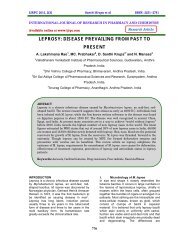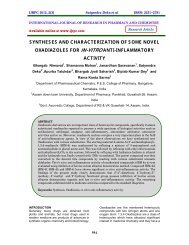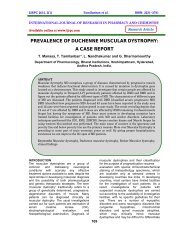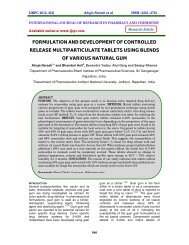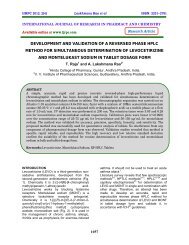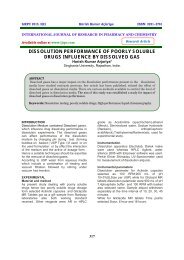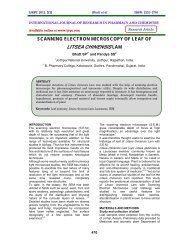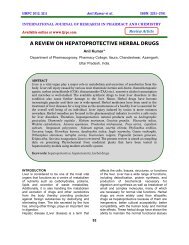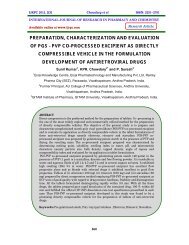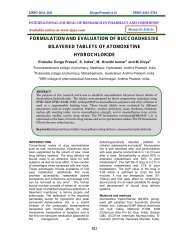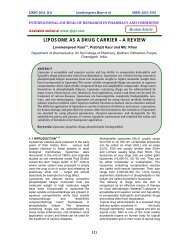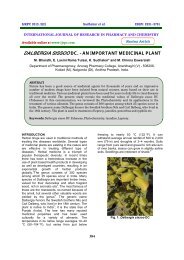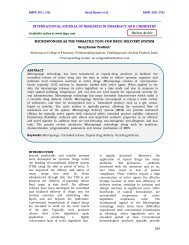microsatellite markers – a novel tool in molecular genetics - ijrpc
microsatellite markers – a novel tool in molecular genetics - ijrpc
microsatellite markers – a novel tool in molecular genetics - ijrpc
Create successful ePaper yourself
Turn your PDF publications into a flip-book with our unique Google optimized e-Paper software.
IJRPC 2012, 2(2) Pokhriyal et al ISSN: 22312781<br />
side might be an “A-Tail,” when the Taq adds<br />
an extra aden<strong>in</strong>e nucleotide onto some copies<br />
of the product, <strong>in</strong>creas<strong>in</strong>g it by 1 bp. It will not<br />
be mistaken for a <strong>microsatellite</strong> allele because<br />
an extreme height difference would not occur<br />
for 2 alleles so close <strong>in</strong> size, as their<br />
amplification efficiencies should be similar.<br />
The black locus is a homozygote. Even though<br />
there is a small black peak on the left side of<br />
the plot, a smaller allele is almost never<br />
shorter than a larger allele. An additional clue<br />
is that the larger black peak is quite fat and tall<br />
-- PCR produces approximately double the<br />
amount of product when an allele is<br />
homozygous because it does not compete for<br />
the Taq with a second allele. The purple locus<br />
represents a “split peak” problem that occurs<br />
from high rates of ATail<strong>in</strong>g by the Taq. The<br />
“+A” peaks occur for all of the stutter peaks,<br />
mak<strong>in</strong>g the scor<strong>in</strong>g difficult, especially for<br />
heterozygotes with closely sized alleles.<br />
Although the true allele is denoted here, a<br />
locus with alleles that look like the purple one<br />
would be too difficult to score reliably. Usually<br />
the problem can be corrected by add<strong>in</strong>g an<br />
extra extension step to the PCR program that<br />
gives the Taq time to add an A-Tail to all<br />
copies of the product consistently.<br />
D) Unscorable loci<br />
The blue locus is a “stegosaur” with<br />
unacceptably high stutter. The black locus has<br />
too many non-specific artifact peaks to reliably<br />
choose the <strong>microsatellite</strong> alleles. The green<br />
locus has been overloaded on the gel or has<br />
unusually high PCR product concentration and<br />
is smear<strong>in</strong>g <strong>in</strong> the lane 3 .<br />
Limitations To Utility of Microsatellites 7<br />
Microsatellites have proved to be versatile<br />
<strong>molecular</strong> <strong>markers</strong>, particularly for population<br />
analysis, but they are not without limitations.<br />
Despite many advantages, <strong>microsatellite</strong><br />
<strong>markers</strong> also have several challenges and<br />
pitfalls that at best complicate the data<br />
analysis, and at worst greatly limit their utility<br />
and confound their analysis. However, all<br />
marker types have some downsides, and the<br />
versatility of <strong>microsatellite</strong>s to address many<br />
types of ecological questions outweighs their<br />
drawbacks for many applications. Fortunately,<br />
many of the pitfalls common to <strong>microsatellite</strong><br />
<strong>markers</strong> can be avoided by careful selection of<br />
loci dur<strong>in</strong>g the isolation process. Speciesspecific<br />
marker isolation PCR-based marker<br />
analysis requires primer sequences that target<br />
the marker regions for amplification. In order to<br />
use the same primer sequence to amplify the<br />
same target from many <strong>in</strong>dividuals, the region<br />
where the primer b<strong>in</strong>ds must be identical, with<br />
few or no mutations caus<strong>in</strong>g <strong>in</strong>ter-<strong>in</strong>dividual<br />
differences. For the gene regions commonly<br />
used as sequenced <strong>markers</strong>, primer regions<br />
are highly conserved, such that they are<br />
<strong>in</strong>variant with<strong>in</strong> species and sometimes even<br />
across broad taxonomic groups. This<br />
sequence conservation necessitates only<br />
m<strong>in</strong>or work to optimize a primer set for a new<br />
species. In contrast, a given pair of<br />
<strong>microsatellite</strong> primers rarely works across<br />
broad taxonomic groups, and so primers are<br />
usually developed a new for each species<br />
(Glenn & Schable 2005). However, the<br />
process of isolat<strong>in</strong>g new <strong>microsatellite</strong> <strong>markers</strong><br />
has become faster and less expensive, which<br />
substantially reduces the failure rate and cost<br />
of new marker isolation <strong>in</strong> many cases (Glenn<br />
& Schable 2005).<br />
Some of the Major limitations <strong>in</strong> utility of<br />
<strong>microsatellite</strong>s are as follows<br />
1. Unclear mutational mechanisms 7<br />
One of the challenges currently be<strong>in</strong>g<br />
addressed by geneticists is that the mutational<br />
processes of <strong>microsatellite</strong>s can be complex<br />
(Schlo¨tterer 2000; Beck et al. 2003; Ellegren<br />
2004). For the majority of ecological<br />
applications, it is not important to know the<br />
exact mutational mechanism of each locus, as<br />
most relevant analyses are <strong>in</strong>sensitive to<br />
mutational mechanism (Neigel 1997).<br />
However, several statistics based on<br />
estimates of allele frequencies (e.g. FST and<br />
RST) rely 618 K. A. Selkoe and R. J. Toonen<br />
2006 Blackwell Publish<strong>in</strong>g Ltd/CNRS explicitly<br />
on a mutation model. Traditionally, the <strong>in</strong>f<strong>in</strong>ite<br />
allele model (IAM), <strong>in</strong> which every mutation<br />
event creates a new allele (whose size is<br />
<strong>in</strong>dependent from the progenitor allele) has<br />
been the model of choice for population<br />
<strong>genetics</strong> analyses, and because it is the<br />
simplest and most general model, cont<strong>in</strong>ues to<br />
be widely used as a default. A model specific<br />
to <strong>microsatellite</strong>s, the stepwise mutational<br />
model (SMM), adds or subtracts one or more<br />
repeat units from the str<strong>in</strong>g of repeats at some<br />
constant rate to mimic the process of errors<br />
dur<strong>in</strong>g DNA replication that generates<br />
mutations, creat<strong>in</strong>g a Gaussian-shaped allele<br />
frequency distribution (Ellegren 2004).<br />
However, nonstepwise mutation processes are<br />
also known to occur, <strong>in</strong>clud<strong>in</strong>g po<strong>in</strong>t mutation<br />
and recomb<strong>in</strong>ation events such as unequal<br />
cross<strong>in</strong>g over and gene conversion (Richard &<br />
Paques 2000). While debate cont<strong>in</strong>ues about<br />
the prevalence of non-stepwise mutation for<br />
<strong>microsatellite</strong>s, the current consensus is that<br />
the frequency and effects are usually low, and<br />
407



